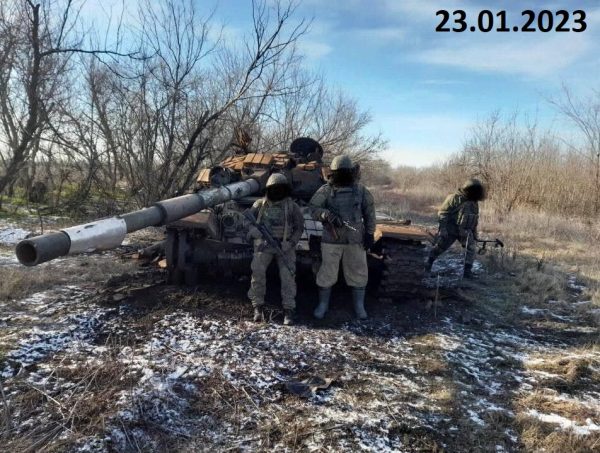War and Propaganda in the Russia-Ukraine Conflict
Guest Post by Ron Unz

We recently passed the first anniversary of the Russia-Ukraine war and the Wall Street Journal published a lengthy review of the twelve months of the conflict, summarizing what had happened and describing future prospects, an article that attracted more than 2,500 comments.
- Ukraine Is the West’s War Now
The initial reluctance of the U.S. and its allies to help Kyiv fight Russia has turned into a massive program of military assistance, which carries risks of its own
Yaroslav Trofimov • The Wall Street Journal • February 25, 2023 • 2,800 Words
 Although hardly critical of our involvement, the writer noted that America and its allies had already provided Ukraine with an astonishing $120 billion in military equipment and money, a figure far larger than Russia’s entire defense budget, with further massive outlays still to come.
Although hardly critical of our involvement, the writer noted that America and its allies had already provided Ukraine with an astonishing $120 billion in military equipment and money, a figure far larger than Russia’s entire defense budget, with further massive outlays still to come.
As the title of the piece indicated, the West had effectively now taken over control of the war, and if the effort to defeat Russian President Vladimir Putin failed, American global influence might be undermined and the future of the NATO alliance called into question. Indeed, such notable foreign policy luminaries as John Mearsheimer, Jeffrey Sachs, Douglas Macgregor, and Lawrence Wilkerson have all recently raised the possibility that NATO risks disintegration, especially in the wake of Seymour Hersh’s bombshell disclosure that President Biden had illegally destroyed the Nord Stream pipelines, some of Europe’s most important civilian energy infrastructure.
So in effect, America is at war with Russia on Russia’s own border, and if we lose that war, the era of our global dominance that followed the 1991 collapse of the Soviet Union might come to an end. Since the earliest days of the fighting, our electronic and social media have functioned as unrestrained cheerleaders, hailing Ukrainian victories and Russian defeats, but this WSJ article could not avoid providing a much more sobering perspective.
Although this war has been of enormous world importance, I’ve actually written very little about the details of the conflict.
I lack any military expertise and doubted that I could contribute anything useful about the fighting, which was anyway obscured by the fog of war. America’s reigning Neocon establishment totally controls the Western mainstream media and over the last few decades they have made propaganda, dishonest or otherwise, one of their most frequently deployed political weapons. Indeed, no sooner had the war broken out than social media was awash with the heroic exploits of “the Ghost of Kyiv” and “the Martyrs of Snake Island,” outright hoaxes that were widely disseminated and believed at the time.
We live in the era of smartphones, so video clips showing Russian tanks destroyed or Russian troops defeated and retreating were widely promoted by partisans of the Ukrainian side. But such anecdotal evidence seemed totally meaningless to me. In 1940 the French army suffered one of history’s most lop-sided defeats at the hands of the Germans, yet if smartphones had been around at the time, it would have been easy for pro-French activists to provide hundreds of clips showing destroyed German panzers or small German units suffering defeat. Such war-porn seems more like entertainment for political partisans than anything having serious value.
This obvious problem soon led some observers to search out a means of more objectively determining combat losses. Many of them began relying upon the Oryx website, run by a purportedly independent “open source” organization that organized and displayed images of destroyed tanks and other military vehicles, thereby allowing analysts to total up the losses suffered by each side in the conflict. Journalists and others soon used this photographic evidence to conclude that the Russians had suffered enormous, almost catastrophic losses, with the under-gunned but highly-motivated Ukrainian defenders destroying huge numbers of Russian tanks and other military vehicles, a result that also suggested very high Russian casualties.
The alleged loss of Russian hardware documented by Oryx seems absolutely staggering. One of the main website pages itemizes nearly 9,500 Russian armored vehicles lost, of which 6,000 were destroyed and nearly 2,800 captured. Those losses included nearly 1,800 tanks, with well over 500 of these captured by the plucky Ukrainians. Each of these listed items is linked to a photograph, most of them either being uploaded separately or contained within a Tweet. For example, 244 destroyed or captured T-72B tanks are listed, all individually numbered and linked to the photographic evidence. Obviously, not all destroyed Russian vehicles would have been swept up, so the true scale of Russia’s apparent losses must surely have been considerably greater. Ukraine’s hardware losses were also cataloged, but they only totaled about 3,000 armored vehicles.
Throughout most of the last year, our mainstream media outlets have been filled with stories of Ukrainian victories and Russian defeats, and surely the large compendium of factual material provided by the Oryx website has been an important reason for this. The Oryx Wikipedia entry runs only three short paragraphs, but explains that the website has been regularly cited by Reuters, the BBC, the Guardian, the Economist, Newsweek, CNN, and CBS, with Forbes hailing Oryx as “outstanding” and “the most reliable source in the conflict so far.” My impression is that many writers on military affairs are enthralled by such photos of heavy equipment, whether intact or destroyed, and Oryx provides many thousands of such striking images, thus capturing their rapt attention.
If the Russians had indeed suffered more than three times the Ukrainian losses in armored vehicles, with well over 500 of their tanks captured by the latter, a Ukrainian military triumph might have seemed very likely, so the Americans and their allies naturally rewarded their victorious proteges with a tidal wave of financial and military support that easily topped a hundred billion dollars.
The supposed Ukrainian achievement was certainly a remarkable one. According to Wikipedia, the largest land offensive in human history was Germany’s 1941 Operation Barbarossa, which involved fewer than 7,000 armored vehicles. But if we credit Oryx, over the last twelve months Ukraine’s doughty patriots have totally annihilated a far greater Russian mechanized force, while their own losses have been just a fraction of that. Individuals should decide for themselves how plausible such total numbers sound.
I only very recently looked at the Oryx website, and the first issue that came to mind was how anyone could possibly determine whether the images were real, faked, or duplicated. According to Wikipedia, the Ukrainian military possessed thousands of tanks, many of them being the same models used by the invading Russians. So if Ukrainian activists uploaded a photo of a destroyed T-72B to Oryx, how can we really be sure it was a Russian tank rather than one of their own? What if several different photos of the same wrecked vehicle were taken from different angles, and separately uploaded? The fighting in the Donbass began in 2014, and can we be sure that the photographs provided are from the current fighting rather than from battles fought years ago?
None of the military enthusiasts whom I asked had any ready answers to those questions, perhaps because they had never even previously considered such troubling possibilities.
During recent decades, Hollywood special effects wizards have displayed great technical skill in showing Spiderman swinging between skyscrapers and the Incredible Hulk undergoing a transformation. Surely producing simple photographs of destroyed military equipment would be a triviality, with the costs almost invisibly small compared to a movie budget. But consider that those simple photographs uploaded to a Dutch website have been a crucial factor in attracting many tens of billions of dollars of financial support from American and allied governments, giving each single image on the Oryx website a potential value of $10 million or more. Producing fake photographs is certainly much safer and easier than destroying Russian tanks in real life, and doing so on an industrial scale would seem a very cost-effective propaganda strategy, so it’s difficult to believe that neither the Ukrainians nor their Neocon/CIA/MI6 mentors ever decided to employ such methods.
Putting the issue in very crude terms, I doubt whether Russian losses may be accurately estimated by aggregating and analyzing what amounted to Ukrainian propaganda-Tweets.
Furthermore, an examination of Oryx’s origins raised other troubling issues.
From the Iraq War onward, the credibility of the American government has steadily deteriorated, considerably weakening the effectiveness of its international propaganda campaigns, a central pillar of its international influence.
Then in 2014 a British blogger named Eliot Higgins established Bellingcat, supposedly an independent research organization that relied upon the objective analysis of open source materials. However, in practice his efforts seemed to almost invariably produce conclusions closely aligned with American foreign policy interests in Syria, Ukraine, and other international flashpoints. This notably including the shoot-down of Malaysian Airlines Flight 17 and the alleged gas attack in Syria that Higgins himself had covered the previous year, always pinning the blame upon governments that were the targets of American hostility.
Numerous distinguished international journalists and other experts, notably including Seymour Hersh, Theodore Postol, and Karel van Wolferen often came to totally different conclusions, but their views were usually ignored by the media, while Bellingcat was heavily quoted in the Western outlets as fully confirming the accusations of the American government. As a consequence, there have been widespread suspicions that Bellingcat merely operated as a tool of Western intelligence services, very similar to how the CIA had established other such front-organizations for propaganda purposes during the original Cold War.
According to the Wikipedia page on Oryx, both its founders were Bellingcat alumni, raising serious questions about whether they are really as independent-minded as they claimed to be.
Meanwhile, other American military experts have provided very different assessments of the course of the war.
For decades, Col. Douglas Macgregor has been regarded as a leading conservative military strategist, authoring several well-regarded books and having many dozens of guest appearances on FoxNews. After having a long career in NATO, he had been a finalist for the position of National Security Advisor, served as a Senior Advisor to the Secretary of Defense, and was nominated as U.S. Ambassador to Germany. He is obviously very well-connected in such establishment military circles, and based upon his Pentagon contacts, he has repeatedly stated that it is actually the Ukrainian forces that have suffered horrendous casualties, including as many as 160,000 combat deaths compared to far lower Russian losses of perhaps 20,000 or so. Other military experts such as Scott Ritter and Larry Johnson have expressed very similar views.
Across all of his numerous interviews, Macgregor comes across as quite persuasive and confident in his assessments of the military situation.
Given the enthusiastic, almost uniform support of powerful Western political, financial, and media interests for the Ukrainian side, I find it difficult to understand why Macgregor, Ritter, Johnson, and others would be taking such contrary positions unless they sincerely believed that they were correct. Indeed, a BBC research effort recently used social media and other open sources to identify 14,709 individual Russian service members killed in the war, a figure that seems quite consistent with Macgregor’s total estimate of 20,000.
So we have diametrically conflicting positions, with Ukrainian officials and the Oryx website claiming Russian losses have been several times greater than Ukrainian ones, while Macgregor and his allies put the ratio at perhaps 8-to-1 in the opposite direction.
I personally lean much more towards Macgregor’s perspective, but I actually doubt that the issue matters much in strategic terms. From the beginning, I’ve never regarded the operational-level details of the fighting in Ukraine as very interesting or important, and haven’t paid much attention to it. This explains why I had never looked at the Oryx website until just a few days ago.
If the Russian army were completely defeated by the Ukrainians and lost control of Crimea and the Donbass, that sort of military disaster for Russia would have major global consequences. But I consider that possibility exceptionally unlikely and doubt that anyone sensible thinks otherwise.
Instead, it seems almost certain that the war will either become roughly stalemated, as many Western analysts seem to believe, or that the Russians will eventually crush the Ukrainians, as predicted by Macgregor and some other Western experts. But unless the latter result draws in NATO forces and leads to a wider war, with possible risk of a nuclear confrontation, I don’t think the strategic consequences are much different in those two contrasting scenarios.
Before the war began, the Russians were widely expected to overwhelm Ukrainian resistance in a matter of weeks, and compared to those early expectations, the war has already been stalemated for a full year.
In hindsight, Russia’s failure to win a quick, decisive victory should not have been too surprising. For example, I’d been entirely unaware that Ukraine actually had an enormous regular army, more than three times the size of Germany’s, and far larger than that of any European NATO country. Much of Ukraine’s military was fully trained to NATO standards, and including reserves and the National Guard, Ukraine deployed more than a half-million ground troops, outnumbering the attacking Russian forces by around 3-to-1, with many of its best units heavily entrenched in strong defensive positions. Under such challenging circumstances, it’s quite understandable that the Russians have required a year of heavy fighting to gain ground against the stubborn Ukrainian defenders, with the latter heavily backed by supplies and assistance from America and the rest of NATO.
But although Russia’s operational progress on the battlefield has been slow and mixed, on the geostrategic level, the Russians have already won a series of major victories. China, Iran, India, Saudi Arabia, and most of the other non-Western countries have clearly moved towards Russia, which also easily surmounted the unprecedented sanctions that most had expected would cripple her economy. The reckless American destruction of the Nord Stream pipelines and the European energy crisis may eventually cause the collapse of NATO. Putin’s domestic approval rating is in the 80s, probably as high as it has ever been. And I don’t see any of these results changing if the military stalemate continues.
One year ago, just after the war broke out, I’d outlined my broader perspective in a long article:
For more than a hundred years, all of America’s many wars have been fought against totally outmatched adversaries, opponents that possessed merely a fraction of the human, industrial, and natural resources that we and our allies controlled. This massive advantage regularly compensated for many of our serious early mistakes in those conflicts. So the main difficulty our elected leaders faced was merely persuading the often very reluctant American citizenry to support a war, which is why many historians have alleged that such incidents as the sinkings of Maine and the Lusitania, and the attacks in Pearl Harbor and Tonkin Bay were orchestrated or manipulated for exactly that purpose.
This huge advantage in potential power was certainly the case when World War II broke out in Europe, and Schultze-Rhonof and others have emphasized that the British and French empires backed by America commanded potential military resources vastly superior to those of Germany, a mid-size country smaller than Texas. The surprise was that despite such overwhelming odds Germany proved highly successful for several years, before finally going down to defeat…
Consider the attitude taken during the current conflict with Russia, a severe Cold War confrontation that might conceivably turn hot. Despite its great military strength and enormous nuclear arsenal, Russia seems just as out-matched as any past American foe. Including the NATO countries and Japan, the American alliance commands a 6-to-1 advantage in population and 12-to-1 superiority in economic product, the key sinews of international power. Such an enormous disparity is implicit in the attitudes of our strategic planners and their media mouthpieces.
But this is a very unrealistic view of the true correlation of forces…just two weeks before the Russian attack on Ukraine, Putin and Chinese leader Xi Jinping held their 39th personal meeting in Beijing and declared that their partnership had “no limits.” China will certainly support Russia in any global conflict.
Meanwhile, America’s endless attacks and vilification of Iran have gone on for decades, culminating in our assassination two years ago of the country’s top military commander, Qasem Soleimani, who had been mentioned as a leading candidate in Iran’s 2021 presidential elections. Together with our Israeli ally, we have also assassinated many of Iran’s top scientists over the last decade, and in 2020 Iran publicly accused America of having unleashed the Covid biowarfare weapon against their country, which infected much of their parliament and killed many members of their political elite. Iran would certainly side with Russia as well.
America, together with its NATO allies and Japan, does possess huge superiority in any test of global power against Russia alone. However, that would not be the case against a coalition consisting of Russia, China, and Iran, and indeed I think the latter group might actually have the upper hand, given its enormous weight of population, natural resources, and industrial strength.
Since the fall of the Soviet Union in 1991, America has enjoyed a unipolar moment, reigning as the world’s sole hyperpower. But this status has fostered our overweening arrogance and international aggression against far weaker targets, finally leading to the creation of a powerful block of states willing to stand up against us.
Then last October, I’d updated my analysis and I think that the subsequent developments have generally confirmed my appraisal:
I wrote those words just two weeks after the war began, and as is inevitable in any conflict, various matters have gone differently than anyone originally predicted.
The Russians had been widely expected to sweep the Ukrainians before them, but instead they have encountered very determined resistance, suffering heavy casualties as they made slow progress. Generously resupplied with advanced weaponry from NATO stockpiles, the Ukrainians recently launched successful counter-attacks, forcing Russian President Vladimir Putin to call up 300,000 reserves.
But although Russia’s military efforts have only been partially successful, on all other fronts, America and its allies have suffered a series of strategic geopolitical defeats.
At the start of the war, most observers believed that the unprecedented sanctions imposed by America and its NATO allies would deal a crippling blow to the Russian economy. Instead, Russia has escaped any serious damage, while the loss of cheap Russian energy has devastated the European economies and severely hurt our own, resulting in the highest inflation rates in forty years. The Russian Ruble was expected to collapse, but is now stronger than it was before.
Germany is the industrial engine of Europe and the sanctions imposed on Russia were so self-destructive that popular protests began demanding that they be lifted and the Nord Stream energy pipelines reopened. To forestall any such potential defection, those Russian-German pipelines were suddenly attacked and destroyed, almost certainly with the approval and involvement of the U.S. government. America is not legally at war with Russia let alone Germany, so this probably represented the greatest peacetime destruction of civilian infrastructure in the history of the world, inflicting enormous, lasting damage upon our European allies. Our total dominance over the global media has so far prevented most ordinary Europeans or Americans from recognizing what transpired, but as the energy crisis worsens and the truth gradually begins to emerge, NATO might have a hard time surviving. As I discussed in a recent article, America may have squandered three generations of European friendship by destroying those vital pipelines.
Meanwhile, many years of arrogant and oppressive American behavior towards so many other major countries has produced a powerful backlash of support for Russia. According to news reports, the Iranians have provided the Russians with large numbers of their advanced drones, which have been effectively deployed against the Ukrainians. Since World War II, our alliance with Saudi Arabia has been a linchpin of our Middle Eastern policy, but the Saudis have now repeatedly sided with the Russians on oil production issues, completely ignoring America’s demands despite threats of retaliation from Congress. Turkey has NATO’s largest military, but it is closely cooperating with Russia on natural gas shipments. India has also moved closer to Russia on crucial issues, ignoring the sanctions we have imposed on Russian oil. Except for our political vassal states, most major world powers seem to be lining up on Russia’s side.
Since World War II one of the central pillars of global American dominance has been the status of the US dollar as the world’s reserve currency and our associated control over the international banking system. Until recently we always presented our role as neutral and administrative, but we have increasingly begun weaponizing that power, using our position to punish those states we disliked, and this is naturally forcing other countries to seek alternatives. Perhaps the world could tolerate our freezing the financial assets of relatively small countries such as Venezuela or Afghanistan, but our seizure of Russia’s $300 billion in foreign reserves obviously tipped the balance, and major countries are increasingly seeking to shift their transactions away from the dollar and the banking network that we control. Although the economic decline of the EU has caused a corresponding fall in the Euro and driven up the dollar by default, the longer-term prospects for our continued currency hegemony hardly seem good. And given our horrendous budget and trade deficits, a flight from the dollar might easily collapse the US economy.
Soon after the outbreak of the Ukraine War, the eminent historian Alfred McCoy argued that we were witnessing the geopolitical birth of a new world order, one built around a Russia-China alliance that would dominate the Eurasian landmass. His discussion with Amy Goodman has been viewed nearly two million times.
It is my sincere desire to provide readers of this site with the best unbiased information available, and a forum where it can be discussed openly, as our Founders intended. But it is not easy nor inexpensive to do so, especially when those who wish to prevent us from making the truth known, attack us without mercy on all fronts on a daily basis. So each time you visit the site, I would ask that you consider the value that you receive and have received from The Burning Platform and the community of which you are a vital part. I can’t do it all alone, and I need your help and support to keep it alive. Please consider contributing an amount commensurate to the value that you receive from this site and community, or even by becoming a sustaining supporter through periodic contributions. [Burning Platform LLC – PO Box 1520 Kulpsville, PA 19443] or Paypal
—————————————————–
To donate via Stripe, click here.
—————————————————–
Use promo code ILMF2, and save up to 66% on all MyPillow purchases. (The Burning Platform benefits when you use this promo code.)
This article has been archived for your research. The original version from The Burning Platform can be found here.



